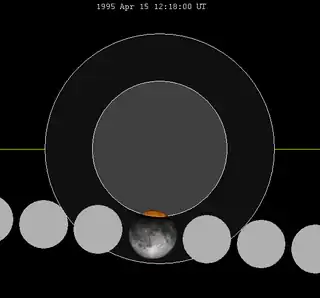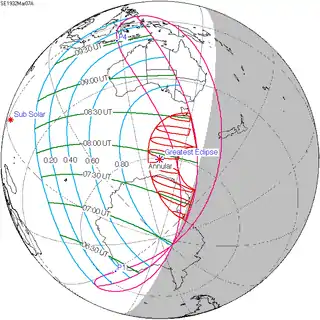March 1941 lunar eclipse
A partial lunar eclipse took place on Thursday, March 13, 1941. The Earth's shadow on the moon was clearly visible in this eclipse, with 32% of the Moon in shadow; the partial eclipse lasted for 1 hour exactly.

Visibility

Related lunar eclipses
| Ascending node | Descending node | |||||
|---|---|---|---|---|---|---|
| Saros | Date Viewing |
Type Chart |
Saros | Date Viewing |
Type Chart | |
| 102 | 1940 Mar 23 |
Penumbral |
107 | |||
| 112 | 1941 Mar 13 |
Partial |
117 | 1941 Sep 05 |
Partial | |
| 122 | 1942 Mar 03 |
Total |
127 | 1942 Aug 26 |
Total | |
| 132 | 1943 Feb 20 |
Partial |
137 | 1943 Aug 15 |
Partial | |
| 142 | 1944 Feb 09 |
Penumbral |
147 | 1944 Aug 04 |
Penumbral | |
Saros series
Lunar Saros series 112, repeating every 18 years and 11 days, has a total of 72 lunar eclipse events including 15 total lunar eclipses.
| Greatest | First | |||
|---|---|---|---|---|
| The greatest eclipse of the series occurred on 1490 Jun 02, lasting 100 minutes.[1] | Penumbral | Partial | Total | Central |
| 859 May 20 | 985 Aug 03 | 1364 Mar 18 | 1436 Apr 30 | |
| Last | ||||
| Central | Total | Partial | Penumbral | |
| 1562 Jul 16 | 1616 Aug 27 | 2013 Apr 25 |
2139 Jul 12 | |
There are 11 series events between 1901 and 2100, grouped into threes (called an exeligmos), each column with approximately the same viewing longitude on earth.
| 1905 Feb 19 | 1923 Mar 3 | 1941 Mar 13 | |||
 |
 |
 |
 |
 |
 |
| 1959 Mar 24 | 1977 Apr 04 | 1995 Apr 15 | |||
 |
 |
 |
 |
 |
 |
| 2013 Apr 25 | 2031 May 07 | 2049 May 17 | |||
 |
 |
 |
 |
 |
 |
| 2067 May 28 | 2085 Jun 08 | ||||
 |
 |
||||
Half-Saros cycle
A lunar eclipse will be preceded and followed by solar eclipses by 9 years and 5.5 days (a half saros).[2] This lunar eclipse is related to two annular solar eclipses of Solar Saros 119.
| March 7, 1932 | March 18, 1950 |
|---|---|
 |
 |
References
- Listing of Eclipses of series 112
- Mathematical Astronomy Morsels, Jean Meeus, p.110, Chapter 18, The half-saros
External links
- Saros series 112
- 1941 Mar 13 chart Eclipse Predictions by Fred Espenak, NASA/GSFC
This article is issued from Wikipedia. The text is licensed under Creative Commons - Attribution - Sharealike. Additional terms may apply for the media files.